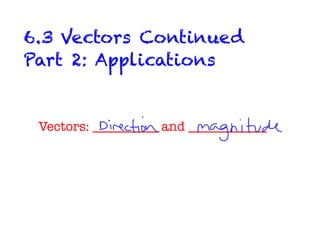Report
Share
Download to read offline

Recommended
Recommended
An adaptive moving total least squares method for curve fitting

An adaptive moving total least squares method for curve fittingAtmiya Institute of Technology and Science (Past)
More Related Content
What's hot
An adaptive moving total least squares method for curve fitting

An adaptive moving total least squares method for curve fittingAtmiya Institute of Technology and Science (Past)
What's hot (12)
A simple formula newton's second law of motion- Race for the Line

A simple formula newton's second law of motion- Race for the Line
An adaptive moving total least squares method for curve fitting

An adaptive moving total least squares method for curve fitting
More from Jonathan Fjelstrom
More from Jonathan Fjelstrom (20)
Pc 6.3 notes_p2_apps
- 1. 6.3 Vectors Continued Part 2: Applications Vectors: __________ and ____________
- 2. Ex. 1) Find the component form of the vector that represents the velocity of an airplane descending at a speed of 100 miles per hour at an angle of 23° below the horizontal.
- 3. Ex. 2) An airplane is traveling at a speed of 724 kilometers per hour at a bearing of N 30° E. If the wind velocity is 32 kilometers per hour from the west, find the resultant speed and direction of the plane.
- 4. Ex. 3) Three forces with magnitudes of 75 pounds, 100 pounds, and 125 pounds act on an object at angles of 30°, 45°, and 120°, respectively, with the positive x-axis. Find the direction and magnitude of the resultant of these forces.
- 5. Assignment: #9 p. 458 #73, 74, 77, 79, 81, 82, 83
